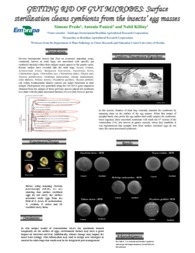Getting rid of gut microbes: surface sterilization cleans symbionts from the insects'egg masses.
Getting rid of gut microbes: surface sterilization cleans symbionts from the insects'egg masses.
Author(s): PRADO, S. de S.; PANIZZI, A. R.; KILLINY, N.
Summary: Diverse heteropteran insects that feed on economic important crops, commonly known as stink bugs, are associated with specific gut symbiotic bacteria within their midgut cryptic spaces or the gastric caeca. Recent studies have revealed that the stink bugs Nezara viridula, Acrosternum hilare, Murgantia histrionica, Euschistus heros, Chlorochroa ligata, Chlorochroa sayi, Chlorochroa uhleri, Plautia stali, Thyanta pallidovirens, Dichelops melacanthus, Edessa meditabunda, Loxa deducta, Pellaea stictica, Piezodorus guildinii, Thyanta perditor, (all within Pentatomidae family) carried one major bacterium in their midgut. Phylogenetic tree generated using the 16S rRNA gene sequences obtained from the midgut of these previous species placed all symbionts in a clade with the plant-associated bacteria Erwinia and Pantoea species. In this system, females of stink bug vertically transmit the symbionts by smearing them on the surface of the egg masses. When first instars of nymphs hatch, they probe the egg surface and orally acquire the symbionts. Once ingested, these microbial symbionts will reach the 4th section of the ventriculum (V4), also known as gastric caecum, where they establish. It was hypothesized that nymphs born from surface sterilized eggs do not carry the caeca-associated symbionts. Once ingested these microbial symbionts will reach the 4th section of the ventriculum (V4), also known as gastric caecum, where they establish. It was hypothesized that nymphs born from surface sterilized eggs do not carry the caeca-associated symbionts. Herne, using scanning eletron microscopy (SEM), we are showing that surface sterilized eggs do not carry the surface microbes while eggs from the field of E. heros, D. melacanthus, N. viridula, P. stitica, and Pi. Guildinii carry them. In this unique model of transmission where the symbionts located temporally on the surface of eggs, environment factors may have a great impact on bacterial survival. Additionally, climate change may impact the insect host ecology. This information may lead to design new strategies to control the stink bugs that could used in the integrated pest management.
Publication year: 2016
Types of publication: Abstract in annals or event proceedings
Unit: Embrapa Environment
Keywords: Insect eggs, Symbionts
Observation
Some of Embrapa's publications are published as ePub files. To read them, use or download one of the following free software options to your computer or mobile device. Android: Google Play Books; IOS: iBooks; Windows and Linux: Calibre.
Access other publications
Access the Agricultural Research Database (BDPA) to consult Embrapa's full library collection and records.
Visit Embrapa Bookstore to purchase books and other publications sold by Embrapa.

